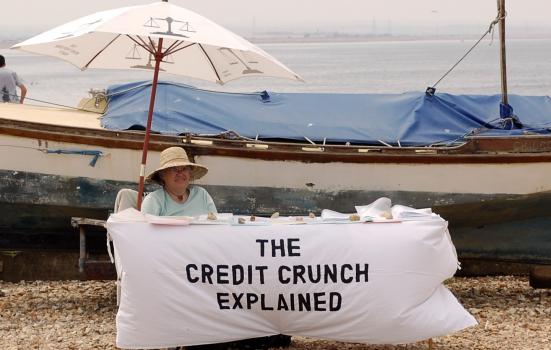Mahmood Reza examines the possible implications of the economic downturn for arts organisations.

paintnothing via CC BY-NC-ND)
Financial events and the economy have dominated the news over the past weeks; the phrase ‘credit-crunch’ has entered the natural lexicon and is seemingly responsible for all of life’s woes. The potential impact on the arts sector could be apocalyptic at worst, or lead to belt tightening and the need for a different risk attitude at best. The arts sector is used to operating in tough times with a rapidly changing financial landscape, and in some respects is more capable of surviving and prospering in a tough economic climate than other sectors.
The beginning of the end?
The root cause of the current situation can be traced back a number of years to the United States. The US, like a number of countries, was enjoying a housing boom due to relatively low interest rates and the fact that the mortgage application process required a relatively small amount of verification and few checks on applicants and their applications. Back in 2004, US interest rates increased and the housing market began to suffer, with prices falling and an increasing number of homeowners defaulting on their mortgages. The UK and US governments and financial authorities are now worried that banks exposed to too many defaulting mortgages might collapse. In a credit-based economy, banks are an essential ingredient in the normal functioning of the economy. The cost and availability of credit affects us all in some way and arts organisations are not immune to these events.
Organisations will have to maintain and develop their sense of excellence, reinforce their 'unique selling proposition', and evaluate their existing plans
The current situation in the arts sector results from the combination of a number of adverse events. There have been significant increased cost pressures from utilities, fuel and insurance costs, and people’s level of disposable income has decreased. This has had a knock-on effect on National Lottery funds which feed into funds provided to the arts councils, which in turn feed into the arts sector. The 2012 Olympic and Paralympics Games have not helped in this respect. An increase in unemployment levels will affect audience levels; the impact will depend on the audience profile of the arts organisation and whether they have been affected by redundancies. The reduction in consumer spending does not directly affect all arts activities. For example, approximately 15% of consumers have cancelled insurance or pension contributions, car breakdown cover, dropped private health and dental insurance, or have cancelled a life insurance policy to save money. This saving is a reduction in committed expenditure. Discretionary spending, such as that on arts activities and entertainment, does not necessarily evaporate.
The potential loss of charity and local authority investments in Icelandic banks will have a direct and indirect affect on the level of funds available to the arts sector. Estimates vary from local authorities losing £880m in deposits and UK charities potentially losing up to £1bn. Figures are not currently available for the specific impact on arts charities. Many of the largest charities appear unaffected by the Iceland crisis. The reduction of available funds, caused by actual and perceived circumstances, has resulted in reduced ticket sales, and a more competitive climate for obtaining sponsorship and donations.
Proactive management
Arts organisations and practioners are, and will be, facing greater pressures due to increasing financial volatility. It is essential that they continue to focus on effective management and control, to maintain stability and deliver core objectives.
Arts organisations should have an embedded proactive risk management strategy. This needs to identify, estimate and evaluate risk, and it needs to be kept up to date. Management and financial control are essential: the main aspects to control are management reporting, performance assessment, record keeping, costing and credit control. Organisations will have to maintain and develop their sense of excellence, reinforce their ‘unique selling proposition’, and evaluate their existing plans, which should be subjected to sensitivity analysis and contingency planning.
Trusts, funders and sponsors are taking a stricter approach to risk assessment of applications for funds and sponsorship. This will make the gaining and maintaining of sponsorship an even more competitive arena. Business organisations will have similar financial and operational challenges to arts organisations: there will be a significant number who will see the benefits of effective working relationships with the arts. Applications will need to be stronger, provide a solid business case and demonstrate capability and sound management. Perception and reality are natural bedfellows: arts organisations and practioners need to maintain a sense of focus, a clear vision and a sense of purpose in an uncertain world.
Mahmood Reza is Proprietor of Pro Active Resolutions.
www.proactiveresolutions.com
T: 0116 224 7122
E: arts@proactiveresolutions.com




